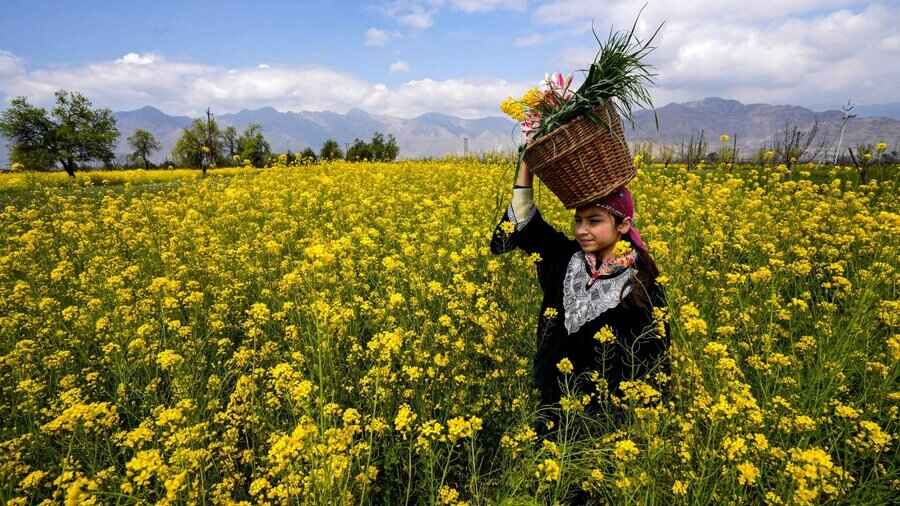Vast stretches of countryside land now find themselves covered not in snow but beds of dainty yellow flowers, lending a welcome touch of colour to the Valley’s landscape — especially along the thoroughfares.
The mustard flowers have become a bit of a tourist attraction, commanding stopovers on national highways and other roads. Even a brief glimpse of the flowerbeds has begun to inspire awe. The number of people panning their cameras and phones at the fields for photographs to remember the Valley’s memorable trip has grown.
“This is my first time witnessing a sea of yellow flowers. The sight in the backdrop of mountains forced us to request our cab driver for a stopover,” Pawan Kumar, a tourist from New Delhi, said of his experience near Pampore in south Kashmir’s Pulwama district.
After a long spell of winter, the bloom of yellow flowers also came as an announcement for the summer. Mustard is the first crop harvested by the Kashmir farmers, who, of late, have begun to understand the economic boom that the mustard and oil seed harvested from the tiny flowers may bring.
This year, the favourable weather doubled the production especially in view of the farmers having brought more land under its cultivation.
Taking notice, the tourism department is also now planning to have stopovers for tourists at mustard fields around the national highway and on the roads leading towards the ski resort town of Gulmarg, Pahalgam and Sonmarg. “For us, mustard fields are becoming a new tourist attraction and we would like to add this in the itinerary of tourists,” a tourist official said.
Identifying the potential of the mustard, officials said the cultivation has increased from 30,000 hectares to 1.40 lakh hectares in Kashmir in recent years.
Agriculture director Iqbal Choudhary said mustard was grown on 30,000 hectares of land in Kashmir up until two years ago, adding, “We made serious efforts, first the target reached 1 lakh hectares in 2022, and this year, it was grown on more than 1.40 lakh hectares in Kashmir.”
Currently every place in the Valley is witnessing a bloom of yellow mustard, he said, noting, “Tourists can be seen enjoying the yellow bloom across Kashmir especially along the national highway.”
Choudhary said the mustard oil seed production has increased manifold and farmers are getting good money for their produce. “Last year they (farmers) sold mustard for ₹9,000 per quintal and this year as per initial reports the rates have increased between 15-20%.”
Mustard in Kashmir is an annual crop and harvested in April and also used as a double crop. The crop is sown in the month of October and harvested in the last week of April and May. The total requirement of edible oils in the UT is ₹14.20 lakh quintal, whereas the UT produces only 3.36 lakh quintal. However, the government is now planning to cover 7.5 lakh hectares under mustard cultivation.
A total of 70,000 hectares of additional areas shall be covered in potential oilseed districts like Kathua, Samba, Jammu, Udhampur, Rajouri, Reasi, Anantnag, Kulgam, Pulwama, Budgam, and Ganderbal and others, by utilising fallow lands, culturable waste lands and leveraging increased cropping intensity apart from promoting intercropping systems,” a government spokesperson said, describing the initiative as crucial for the region’s food security and economic growth.
Notably, Jammu and Kashmir lieutenant governor Manoj Sinha had on Sunday termed mustard bloom as a yellow revolution, saying the region has registered significant growth in oilseed produce.

